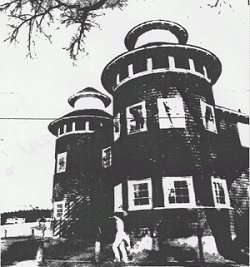GODDARD CHANGES DRASTICALLY, BUT STAYS VIABLE
PLAINFIELD -- The road to recovery for Goddard College has been a torturous one,
full of blind turns and obstacles that repeatedly put the school on the brink of collapse.
The past two years have required painstaking, and often painful, decisions that
have brought drastic changes to the experimental, progressive liberal arts institution.
College President Jack Lindquist would like to think he has helped steer the college
along a course that will assure its survival.
A recent decision by the New England Association of Schools and Colleges brought a
breath of life into Goddard, which has been struggling to convince prospective
students, as well as creditors, guidance counselors and financial aid institutions,
that it can make a comeback.
The association agreed to remove Goddard's two-year probationary status, meaning
the college for the time being is not threatened with loss of accreditation.
"That decision tells the world this isn't a place that's shaky and isn't a
good bet. It says this is a place that is getting its act together," Lindquist said.
A decision to lift its accreditation probably would have meant the end of the
44-year-old institution.
"Frankly, we probably would have closed the college and tried to reorganize,"
Lindquist said.
Lindquist, 41, former academic dean of the college, took over as president in
May 1981 after a series of tumultuous events.
Three administrators, including the president, John Hall, resigned. The next
president, Victor Loefflath-Ehly, resigned a year later. With the impending threat
of financial collapse, faculty and staff worked without pay for three weeks to help
keep the college alive.
With a debt of nearly $3 million, further sacrifices were unavoidable, according
to administrators. Four of Goddard's programs were sold to Norwich University and
Vermont College, and a large part of the campus was put up for sale. A large portion
of the faculty was laid off, and the college administration was slashed.
A student who attended Goddard during the 1960s or early '70s would find a very
different institution today.
Where there were once as many as 1900 students, there are now 153. Two years ago,
the enrollment was about 1000, Lindquist said.
The general perception of the college was that it had overextended itself in
the 1960s, and it scaled down its enrollment drastically, Lindquist said.
That did not require much weeding out at the admissions office, where applications
had dropped off almost completely.
When the New England association decided two years ago to recommend that
accreditation be lifted, newspapers nationwide reported the accreditation actually
had been lifted.
In fact, Goddard successfully appealed the recommendation and its accreditation
remained intact, although the facility was placed on probation.
But the image of a broken college remained, and still haunts the school.
"Our enrollment just stopped then," Lindquist said. "Our public image was that
the school had been closed. When I showed up at conferences with the name tag that
said Goddard, people looked confused and say, 'is that the Goddard that closed?'" he said.
In the fall 1980, Lindquist was hired as a consultant to a five-member task
force given the uneviable task of "total reorganization in one year," he said.
He was named acting president in May 1981.
While the 1960s and '70s represented a period of great growth for the institution,
the 1980s will be a time of pared-down enrollment and a streamlined administration,
Lindquist said.
"Our current plan is to move back to 250 to 300 students and stay there,"
Lindquist said. "We feel it's a much more effective institution at that number,
and better educationally."
When he took over the presidency, Lindquist said even he had doubts about the
college's survival. While that is by no means certain, he now believes the college
is on the road to recovery.
"It's going to happen. The accreditation solidifies that," he said. "But it
isn't going to happen easily. There will be some delicate times as we nurse it
along... and a lot of work needs to be done to improve the public image."
One way the college has been combating soaring energy costs is by encouraging
students to work on independent studies off campus. Only a third of the student
body lives on campus; the rest are scattered across the globe, doing research
projects, writing books, were doing other creative pursuits.
Lindquist said the financial benefits are not the only reason the college has
encouraged the nonresidency programs.
"Progressive education has always had its roots in integrating working and
learning," he said. While many view a liberal arts education has an impractical
luxury, a progressive education can be as practical as any, Lindquist said.
"During a recession, many people are concerned about getting jobs, and so in many
ways, an education that involves working in the 'real world' is more practical," he said.
Novelette Stewart, a Goddard junior, said that throughout all the turmoil the
college has been going through, students remained committed to the institution.
"At Goddard, you have a very unique set of students who stuck together when we
didn't know if we'd be open from one week to the next," she said.

The Silos. The student body has shrunk to about
one-tenth its former size, but students say the
Plainfield college will live on.

